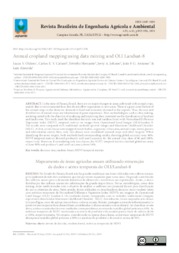Annual cropland mapping using data mining and OLI Landsat-8.
Annual cropland mapping using data mining and OLI Landsat-8.
Author(s): OLDONI, L. V.; CATTANI, C. E. V.; MERCANTE, E.; JOHANN, J. A.; ANTUNES, J. F. G.; ALMEIDA, L.
Summary: ABSTRACT: In the state of Paraná, Brazil, there are no major changes in areas cultivated with annual crops, mainly due to environmental laws that do not allow expansions to new areas. There is a great contribution of the annual crops to the domestic demand of food and economic demand in the exports. Thus, the area and distribution of annual crops are information of great importance. New methodologies, such as data mining, are being tested with the objective of analyzing and improving their potential use for classification of land use and land cover. This study used the classifiers decision tree and random forest with Normalized Difference Vegetation Index (NDVI) temporal metrics on images from Operational Land Imager (OLI)/Landsat-8. The results were compared with traditional methods spectral images and Maximum Likelihood Classifier (MLC). At first, seven classes were mapped (water bodies, sugarcane, urban area, annual crops, forest, pasture and reforestation areas); then, only two classes were considered (annual crops and other targets). When classifying the seven targets, both methods had corresponding results, showing global accuracy near 84%. NDVI temporal metrics showed producer?s and user?s accuracy for the annual crop class of 86 and 100%, respectively. However, if considering only two classes, the NDVI temporal metrics reached global accuracy of near 98% and producer?s and user?s accuracy above 94%.
Publication year: 2019
Types of publication: Journal article
Observation
Some of Embrapa's publications are published as ePub files. To read them, use or download one of the following free software options to your computer or mobile device. Android: Google Play Books; IOS: iBooks; Windows and Linux: Calibre.
Access other publications
Access the Agricultural Research Database (BDPA) to consult Embrapa's full library collection and records.
Visit Embrapa Bookstore to purchase books and other publications sold by Embrapa.

